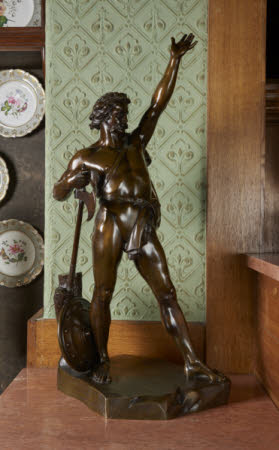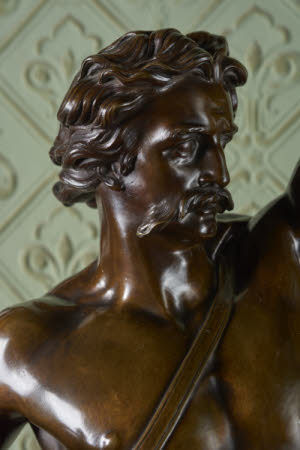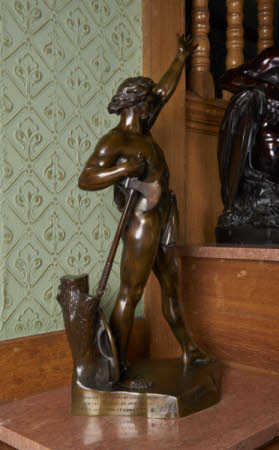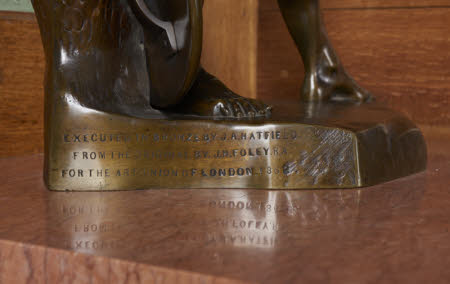Caratacus, king of the Britons
John Ayres Hatfield (1815-1881)
Category
Art / Sculpture
Date
1862
Materials
Bronze
Measurements
787 mm (H)
Place of origin
London
Order this imageCollection
Cragside, Northumberland
NT 1228375
Summary
Sculpture, bronze; after John Henry Foley (1818-74); Caratacus; 1862. A bronze reduction of a marble statue of Caratacus (or Caractacus), king of the Britons, completed by Foley in 1859 and today in Mansion House in the City of London. The cast was made by the bronze founders Hatfields and published by the Art Union of London in 1862.
Full description
A figure of Caratacus, king of the Britons, standing defiantly, his legs astride, his left arm raised high. Caratacus is bearded and naked, except for a drapery, one end of which is fastened under a strap over his left shoulder and the other by a decorated belt around his waist. In his right hand he holds an axe by the top of its shaft, the end of the shaft resting on a tree-stump behind Caratacus’s right leg. Against the side of the tree trunk is propped a bossed and studded shield. The sculpture is on an irregular rocky base, on the side of which is an inscription identifying the founder J.A. Hatfield, the sculptor of the original model J.H. Foley and the publisher, the Art Union of London. The bronze is a reduction of a full-size marble by John Henry Foley in Mansion House in the City of London, one of a series of twenty-five statues at Mansion House that were commissioned by the Corporation of the City of London from 1856. The purpose of the commissions was both practical, the provision of suitable display pieces, especially for the large Egyptian Hall with its niches, but also a broader patriotic aim to promote British sculpture (for the sculptures, see Julius Bryant, Magnificent Marble Statues. British Sculpture in the Mansion House, London 2013). The Caratacus (Magnificent Marble Statues, no. 7) was one of six sculptures commissioned by the Corporation in the spring of 1856 and was completed by 1859. It is one of two sculptures by John Henry Foley at the Mansion House, the other a female figure, Egeria, made earlier in 1853-55 (Magnificent Marble Statues, no. 6). Whereas that figure was mythological, taken from Ovid’s Metamorphoses, the Caratacus was a key subject from British history, and an overt celebration of British freedom of spirit. Caratacus or Caractarus (fl. A.D. 40-51) was the son of the greatest king of Iron Age Britain, Cunobelinus, who died in around A.D. 40, and whose power base had been in the south eastern parts of Britain. Whilst Cunobelinus had sought to maintain good relations with the Romans entrenched across the English Channel in Gaul, attitudes hardened after his death, to the extent that in A.D. 43 the Roman emperor Claudius launched an invasion of Britain. Over the next eight years, from his bases in Wales Caratacus provided the most effective opposition to the steady advance of the Roman invaders. However, he was eventually defeated in 51, captured and sent to Rome. In Rome, Caratacus was reported to have mounted a dignified and eloquent defence of his conduct, with the result that he and his family had their lives spared. Foley’s sculpture depicts the Briton in defiant pose, as if challenging the Roman invaders from his Welsh fastness, much appealing to British notions of patriotism. As the Art Union Council’s report for 1873 put it, the sculpture was to be seen as ‘an excellent embodiment of stalwart strength and patriotic devotion.’ (Avery and Marsh, ‘The Bronze Statuettes of the Art Union of London’, p. 334). John Henry Foley (1818-74) was one of the most important sculptors working in Victorian Britain (for Foley, see Paula Murphy, Nineteenth-Century Irish Sculpture. Native Genius Reaffirmed, New Haven/London 2010, pp. 104-27). Born in Dublin, Foley moved to London in 1834 and entered the schools of the Royal Academy, where he began exhibiting from the later 1830s. Among the sculptor’s many commissions in Britain and Ireland were the monument to Daniel O’Connell in Dublin and the group representing Asia, on the Albert Memorial in London. A number of John Henry Foley’s works were popularised through the editions of the Art Union of London. The Art Union has been described as ‘one of the most remarkable artistic phenomena of the nineteenth century’ (Elizabeth Aslin, ‘The Rise and Progress of the Art Union of London’, Apollo, 85 (January 1967), pp. 12-16, p. 12). Founded in 1836, it was a subscribing lottery, prize-winners in which were able to use their winnings to purchase a work of art. The Union flourished in its early decades and played a major role in improving the standards of bronze-casting in Britain, but it entered a long decline from the 1870s, eventually closing in 1911. Early in its history, rather than just providing funds for winners in its lotteries to buy works of art on open market, the Union began to commission for its members editions of works of art - prints, medals and small bronze or Parian-ware reductions ‘of some celebrated group or piece of sculpture to a size fitted for a drawing room table.’, as a committee suggested in 1842. The aim was to create ‘a very efficient instrument in diffusing a taste and love for art in many a family circle.’ In its heyday, from the 1840s through to the 1870s, the Art Union played a major role in expanding the market in Britain for sculpture, generally improving taste and helping radically to improve bronze-casting skills, hitherto much inferior to those of the French foundries. Bronzes seem to have been usually commissioned in editions of between twenty and fifty, but could be offered over more than one year. The reduction of Foley’s Caratacus was first produced in 1860, but must have become especially popular from 1862, the date of the Cragside example, since it was in this year that Foley’s original marble statue was one of nine of the marble statues for Mansion House that were lent to the South Kensington International Exhibition. Another cast dated 1862 was sold at Bonham’s in 2011 (11 January, lot 179). The bronze evidently continued to be produced for many years, an example in the National Gallery of Ireland in Dublin, also cast by Hatfield, being dated 1894 (Inv. NGI.8258) Avery and Marsh, ‘The Bronze Statuettes of the Art Union of London’, fig. 13) and another in Peterborough Museum and Art Gallery (Inv. PETMG:1937.093.122) as late as 1908. As well as Hatfield’s, Elkington also made bronze reductions of the Caratacus (Grant and Patterson, The Museum and the Factory, p. 73, fig. 48). John Ayres Hatfield (1815-1882) established his business as a ‘bronzist’ in 1844, engaging in the manufacture of bronzes and ormoulu decorations, and also the cleaning and restoration of bronzes. The firm ceased to cast bronzes in the twentieth century but continues to this day as a conservation and restoration specialist. Hatfields were responsible for casting the greater portion of the Art Union’s bronzes. John Henry Foley’s Caratacus characterised the rather severe academic classicism against which the later nineteenth-century New Sculpture movement in Britain, led by Alfred Gilbert and others, began strongly to react, in their search for a more naturalistic approach to form. In 1883, the critic Edmund Gosse commented that Foley’s Caratacus did little more than to evoke a naked Englishman of good physique, ‘looking as if something or other had annoyed him very much.’ (Susan Beattie, The New Sculpture, New Haven/London 1983, pp. 1-2, fig. 2). Jeremy Warren March 2022
Provenance
Armstrong collection. Transferred by the Treasury to The National Trust in 1977 via the National Land Fund, aided by 3rd Baron Armstrong of Bamburgh and Cragside (1919 - 1987).
Marks and inscriptions
On the base, near the shield: EXECUTED IN BRONZE BY J. A. HATFIELD. / FROM THE ORIGINAL BY J. H. FOLEY, R. A. / FOR THE ART-UNION OF LONDON 1862
Makers and roles
John Ayres Hatfield (1815-1881), artist after John Henry Foley, RA (Dublin 1818 - London 1874), artist
References
Avery and Marsh 1985: Charles Avery and Madeleine Marsh, ‘The Bronze Statuettes of the Art Union of London: The Rise and Decline of Victorian Taste in Sculpture’, Apollo, 121 (1985), pp. 328-37, pp. 333-34, fig. 13. Beattie 1983: Susan Beattie, The New Sculpture, New Haven and London 1983, pp. 1-2, fig. 2. Roscoe 2009: I. Roscoe, E. Hardy and M. G. Sullivan, A Biographical Dictionary of Sculptors in Britain 1660-1851, New Haven and Yale 2009, p. 470, no. 38 Murphy 2010: Paula Murphy, Nineteenth-Century Irish Sculpture. Native Genius Reaffirmed, New Haven/London 2010, pp. 109-10, fig. 152. Bryant 2013: Julius Bryant, Magnificent Marble Statues. British Sculpture in the Mansion House, London 2013, no. 7. Grant and Patterson 2018: Alistair Grant and Angus Patterson, The Museum and the Factory. The V&A, Elkington and the Electrical Revolution, London 2018, p. 73, fig. 48.




